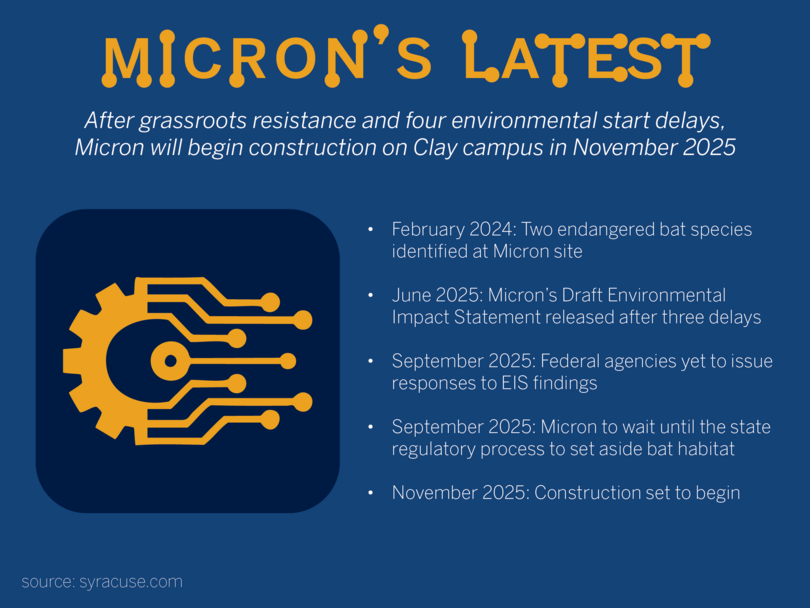Micron’s Clay facility construction updates, start date delays

Micron Technology is required to complete an environmental impact statement, endangered species assessments and regulatory approvals which have proved difficult, causing the company multiple construction delays. Caroline Daugherity | Design Editor
Get the latest Syracuse news delivered right to your inbox.
Subscribe to our newsletter here.
After four start delays, Micron Technology’s groundbreaking is slated for November, nearly three years after the announcement of its arrival in central New York.
The company’s required environmental impact statement, endangered species assessments, regulatory approvals and coordination with government agencies proved difficult to complete by its initial summer 2024 construction date.
Released in June, its drafted EIS — which investigates the facility’s water, air and native species regional impact — took two years, causing three delays. Proposed improvements, such as a new exit on I-81, a rail spur site for trucks to mitigate traffic and efforts to restore wetlands in the community, were also included in the report.
Responses from federal agencies regarding the EIS are expected to be released in late September, taking 600 public comments into consideration, according to a Jobs to Move America release.
Several local social justice and environmental watch organizations, including SUNY ESF’s Center for Native Peoples and the Environment and the Sierra Club, released responses in June criticizing the report and Micron’s impact.
Public comment on the EIS raised concerns regarding Micron’s pollution impact, according to a letter from the Sierra Club, a grassroots environmental organization. The letter criticizes Micron’s planned four semiconductor facilities compared to two or three.
Micron’s Clay campus is set to feature four semiconductor fabrication plants, or “fabs,” making it a “megafab” campus. The project will invest up to $100 billion within the next 20 years.
The Sierra Club claims the EIS doesn’t follow Micron’s previously proposed commitments of a 100% renewable energy facility. It also says the company fails to meet New York state’s renewable energy goals and is inconsistent with state law.
New York state law requires that the establishment of specific technological programs meet the state’s energy goals under the Climate Act. Companies must reduce harmful air pollution and ensure a low-carbon energy supply.
The Sierra Club also said the report failed to adequately name all PFAS or poly- and perfluoroalkyl substances and quantities, chemicals essential to making computer chips, which pose a potential harm to workers.
Micron first halted construction in February 2024 until November 2025 after discovering two species of endangered bats across the 1,400-acre site in Clay, preventing the company from clearing trees for construction.
The plant has to wait until the state regulatory process for bat mitigation is complete, and will work with the state to purchase or set aside a habitat for the bats.
Over the summer, Micron also began its hiring process, recruiting people to run the project’s construction, syracuse.com reported. In need of up to 5,000 construction workers, local colleges will start training students to work these plants, including Syracuse University and Onondaga Community College.
Each fab will employ 9,000 people, with an overall estimated employment of 40,000 people in central New York, Micron said in a 2022 release.
SU’s College of Engineering and Computer Science hired over 12 professors in the past two years in preparation for Micron’s opening. The university plans to continue hiring 12 to 15 new professors before the company’s opening, according to syracuse.com.
Earlier this month, President Donald Trump said “fairly substantial” tariffs will be put on imported microchips, syracuse.com reported. Micron will not be affected by these tariffs as the chips are domestically produced.
Construction on its first fab will begin November 2025.





